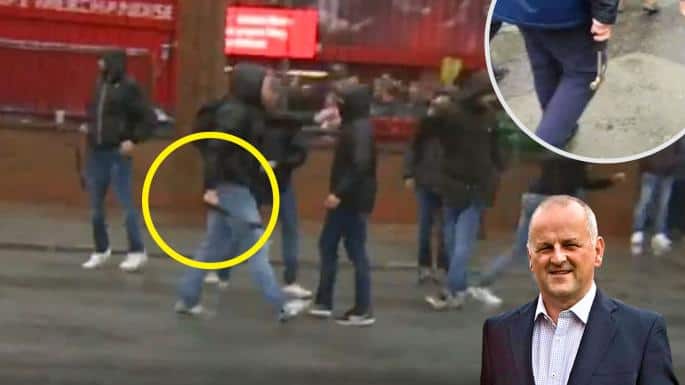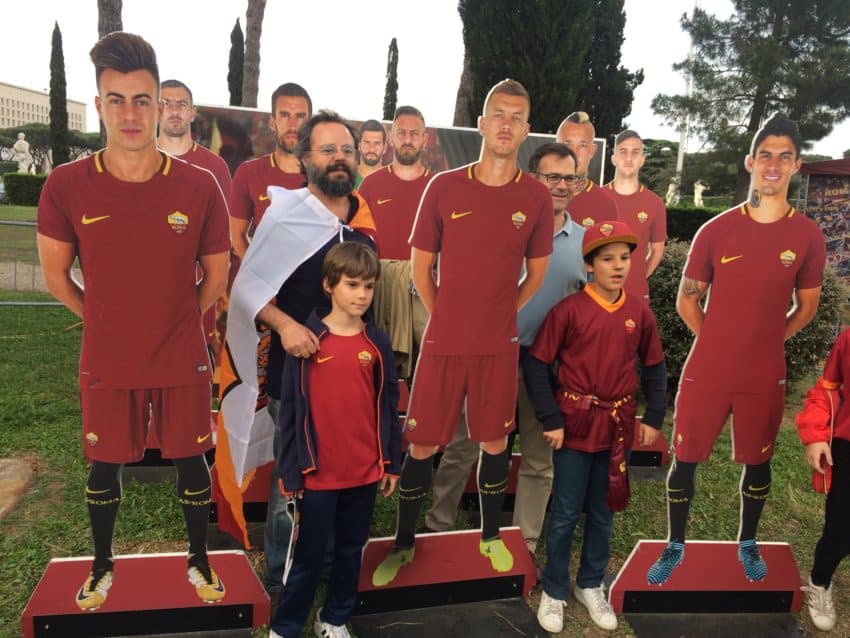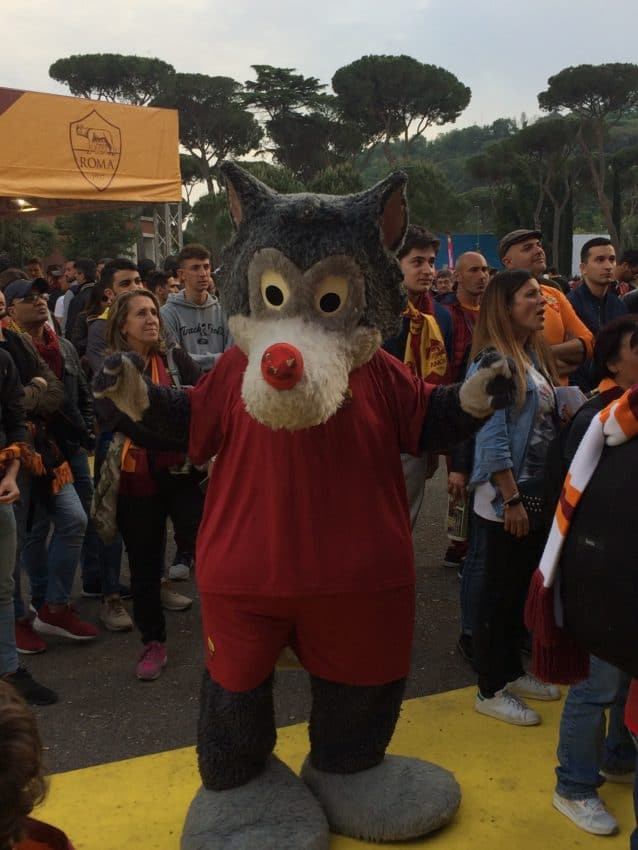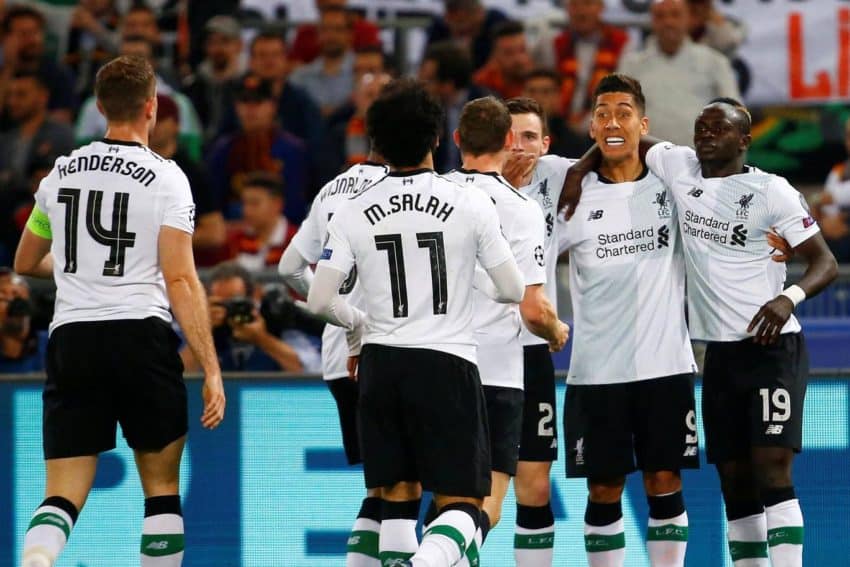A man remains in a coma as Champions League semi shines another spotlight on AS Roma’s vicious soccer fans

Peter Mooney is one of those European soccer fans who could tell you the best pubs all over Europe. He has followed his beloved Liverpool to Madrid, Barcelona, Dortmund. This week he found himself in Rome where he packed a little lighter. What did he leave back home in England?
Anything red.
I met him Tuesday night in the best pub in Rome, my Abbey Theatre Irish Pub in Centro Storico. He sat at the end of the bar wearing shorts and a nondescript shirt. He nursed a beer with his son and brother-in-law, also Liverpool fans and also wearing earth tones. They didn’t think it was a matter of packing. This week it was a matter of survival.
“We haven’t told anyone we’re Liverpool fans,” Mooney said. “We haven’t worn our tops. We’ve come here sort of incognito.”
Sport’s value to society is it unites the masses. It’s where a seven-figure stockbroker can sit in a dive bar in Queens with an unemployed iron worker and high five after a touchdown. At Abbey Theatre, art historians sit with coffee jockeys and scream at the flat screens.
But in Europe, soccer can also divide the masses. In Rome, soccer has become a lightning rod for the kind of violence that transcends world news. Over the last week, it struck hard here again. Before AS Roma’s first leg of its Champions League semifinal at Liverpool last week, a brawl between the two fan bases erupted outside the stadium. Sean Cox, a 53-year-old married father of two, who comes to Liverpool from his native Ireland for games, was left in a coma. Two Roma fans are charged with beating him half to death with belts wielding metal buckles. Filippo Lombardi, 21, and Daniele Sciusco, 29, two members of Roma’s vicious ultras fan group, remain in custody in Liverpool. Their charge of attempted murder has been reduced to the seemingly tame violent disorder and wounding/inflicting grievous bodily harm.
Meanwhile, Cox remains in a coma with his wife by his side. Officials are mulling an attempt to take him out of his induced coma but his condition hasn’t changed since the attack nine days ago.
I remember watching video of the brawl that night. It reminded me of the street fights that made English soccer the most feared grounds in the world in the 1980s. A pack of half dozen fans threw wild haymakers at a single individual who flailed away with his head down, trying to avoid the punches. I don’t know if it was Cox. Bodies moved in waves and fists all over the street. Later I saw a prone body, Cox, under two concerned fans as others scattered.
England has heroically cleaned up its hooligan act. The English government has used video to arrest violent fans and pull their passports. I remember covering England’s 2006 World Cup opener in Frankfurt against Uruguay, and the English were as respectful as the Royal Family. However, Mooney is used to violence.
He’s a retired cop.
He just never expected he’d have to relive bad memories in Rome.
“In those three (other) cities, they’ve embraced us,” Mooney said. “In fact, they’ve invited us into their bars: ‘Come drink with us.’ They’re football fans! It’s a game of football! And unfortunately, we’ve come here and it’s a little worrying, yes.”
Liverpool gave their 5,000 fans coming to Rome a litany of instructions to remain safe. It designated two areas in the city to congregate: Centro Storico and a bar near the Colosseum. Don’t go anywhere near Ponte Milvio, the historic bridge that’s a massive Roma stronghold near Olympic Stadium. To get to the game, they were all gathering in Villa Borghese, Rome’s huge park, and pile into buses. After the game, they were to remain seated for two hours until Roma fans left before police escorted the English back onto the buses.
Said one Liverpool fan I met, “The media has told us we’re going into a war zone.”
This isn’t just about worries of retaliation. This is about Roma history. After four years here and 5 ½ over two stints, I’m slowly learning my beloved club has developed one of the most violent reputations in the world. And they’re particularly active against English clubs. According to media reports:
* In 1984 after Liverpool defeated Roma in a shootout for the European Cup (predecessor to the Champions League) at Olympic Stadium, “dozens were slashed by knife-wielding hooligans.”
* In 2001, before Liverpool’s 2-0 win over Roma in the UEFA Cup, Roma fans stabbed six Liverpool fans and police had to fire tear gas. During the game, Roma fans threw coins, golf balls and rocks at the 4,000 Liverpool fans in their designated corner of the stadium. Other Roma fans invaded the neutral section between fan groups, broke away seats and hurled them over the Plexiglas fence into Liverpool’s section.
* In 2006, three Middlesbrough fans were stabbed and 10 others treated for injuries.
* In 2007, five Manchester United fans were stabbed in their behinds — yes, their asses — before their Champions League game in Rome.
* In 2009, an Arsenal fan was stabbed by fans who stormed the Arsenal fans’ bus.
* On Oct. 31, Chelsea fans were attacked outside a pub.
This doesn’t include the 2014 Italian Cup final between Napoli and Fiorentina when Napoli fan Ciro Esposito died from a gunshot to the chest. He was 29. Roma ultra Daniele De Santis was sentenced to 26 years in prison, later reduced to 16 on appeal. Roma wasn’t even playing. Two years later, Napoli built a monument honoring Esposito. Roma fans desecrated it.
It’s not the only time Roma was linked to violence without its team showing up. Before the 1985 European Cup final at Heysel Stadium in Brussels, Liverpool fans charged Juventus fans and a fence collapsed, killing 39 people, mostly Italians, and injuring 600. The lasting theory in England is if Roma hadn’t attacked Liverpool fans the year before, the Heysel Stadium disaster never would’ve happened.
What have I got myself into? My transformation from sports writer to sports fan has apparently landed me in the middle of a new Roman Empire in which Romans attack fans instead of countries. Half my wardrobe is red and yellow. I’ve made a point never to wear Roma gear in other European cities.
One major factor that attracted me to AS Roma way back in 2001 is it wasn’t Lazio. Our bitter cross-town rival has a fascist reputation in which its history of racist incidents is too long to print. The Internet has only so much cyberspace. Yet the history of shame my own fan base is writing makes me leave the laziali alone. After all, who the hell am I to talk?
Who are these people? I’ve been to Olympic Stadium numerous times and never even seen a shoving match. I’ve watched games on TVs filled with romanisti in public places all over Rome and never once encountered the type of savage thug I’ve read about. I even encountered a huge table full of Roma ultras in La Fraschetta di Castel Sant’Angelo, a designated Roma trattoria, and they welcomed me with open arms. All I had to do was flash my AS Roma keychain. Through traveling to 101 countries, I’ve said Romans are the nicest people I’ve ever met.
Yet somewhere deep in the bowels of this rabid fan base is a soft underbelly of violence that bely Rome’s worldwide reputation as a place of beauty, art and love. It’s like you open up your cabinet of expensive china and a rat leaps out.
I’m a student of history. I learn from it. That’s why I ventured out Tuesday night figuring I’d encounter 5,000 bloodthirsty Liverpool fans bent on revenge. It didn’t happen. Campo dei’ Fiori was nearly empty when I stopped for a beer at The Drunken Ship, one of Rome’s wildest bars, at about 6 p.m.
Abbey Theatre was packed. Yet I saw no one in red. Liverpool fans were pounding the beers but no one was drunk. No one was angry. Everyone was happy. In fact, during Liverpool’s Champions League charge through Hoffenheim, Germany; Moscow; Maribor, Slovenia; Seville, Spain; Porto, Portugal; and Manchester, England, not one Liverpool fan has been arrested.
They came to Rome with a surprisingly level-headed perspective. Mooney indicated the “riot” in Liverpool wasn’t as widespread as the video indicated.
“There was one piece of trouble,” said Mooney who attended the game. “Some Roma fans essentially, when everybody went into the grounds, at the very last minute went around to another part of the stadium at the home end and picked on a small group of middle-aged men who were about to get into the stadium. It wasn’t a big crowd.”
It also helps that English hooligan has become nearly extinct, not only thanks to the government but basic economics.
“If you look at the demographics of Premiership fans nowadays, it’s still working class but we’re sort of middle class,” Mooney said. “Because it’s so expensive to go to a game now that you haven’t got the same sort of people going to soccer.”
Underneath the jacket of Christian Dalley, a Liverpool fan living in London, was a white T-shirt with a red outstretched hand, indicating the five Champions League titles Liverpool has won.
“I’m going subtle,” he said. “My friend and I flew over from London Monday and our Facebook has been blown away. We had 120 hits, everyone saying, ‘Be safe. Be safe.’ We’re going to a football match! This is ridiculous! We’re not going to Syria.”
Added his friend, Ali Farwana, a Lebanese-American, “Anybody came to look for revenge is complete bullshit. We came to support Liverpool.”
At the end of the evening, I returned to Campo dei’ Fiori where the red army finally arrived. Only, of course, they weren’t wearing red. About 200 Liverpool fans had gathered outside I Gigante della Notte bar hysterically singing Liverpool’s famed theme song, “You’ll Never Walk Alone.”
A huge police paddy wagon was off to the side. Some police stood behind, looking bored. Feigning naivety, I asked one fan why no one was wearing red.
“The Roma fans are very violent and we’re trying to avoid being attacked,” said Joe Cocorachio of Bournemouth, England.
I asked if they’ve met any Romans who found out they’re Liverpool fans.
“Not so far,” Cocorachio said, “but the night is young.”
With this atmosphere as a backdrop, Wednesday’s game became almost an afterthought. Then again, when Roma lost 5-2 in Liverpool in the first of the two legs, the dream of advancing to its first European final since that ‘84 game had been pretty well crushed for a week. Yes, Roma stunned Barcelona 3-0 in the second leg of the quarterfinals to advance on away goals but Roma played well despite losing 4-1 at Barcelona. In Liverpool it was awful. Terrible mistakes in the midfield caused Roma’s defenders to get overrun by Liverpool’s cheetah-fast forwards. Mohamed Salah, the Egyptian superstar Roma sold last year and preceded to become Premier League Player of the Year, had two goals and an assist and a pyramid named after him.


When I reached Olympic Stadium, the crowd at River Cafe across the street spilled up and down the road. Yellow smoke obscured some of the patrons roaring songs and chants, believing Roma still had a chance. Inside the gates I found almost a carnival atmosphere. Children played foosball with their fathers. Kids posed with life-size cutouts of the Roma roster. An MC yelled out contest giveaways on a polished stage. I walked into the press entrance and the ever-present orchestra playing classical music didn’t present much of a violent image.
Entering the stadium, however, you felt the atmosphere that has often been compared to the Roman Colosseum, circa 100 AD. The jam-packed crowd of 63,000 was roaring before any player even took the field. So many red and yellow flags flew in the ultras’ Curva Sud, that end of the stadium looked like a giant quilt.
Also, no fans in the world boo like Roma fans. Philadelphia’s? It’s the College of Cardinals in comparison. Liverpool’s goalkeepers came out to warm up and the whistles sounded like 60,000 really pissed off bees. It got even louder every time Salah kicked the ball — in warmups.
Three rows of security guards were between the Liverpool section and Curva Nord. I thought I saw two red shirts.
The cauldron cooled in nine minutes. That’s how long it took for Radja Nainggolan, my favorite player and one of the best midfielders in Europe, to make a weak back pass to defender Federico Fazio who was leaning back at the time. Roberto Firmino intercepted it, passed it to Sadio Mane’ who found himself one on one with goalkeeper Alisson Becker. It was no contest. Liverpool was up 1-0 and 6-2 on aggregate. Roma had to score four times and Liverpool hadn’t give up four goals since a 4-1 loss at Tottenham Oct 22, a span of 37 games.
Nainggolan buried his head in hands and looked like the only place he wanted to be was anywhere in the world but the middle of Olympic Stadium.

Roma won 4-2 to lose only 7-6 on aggregate, but it wasn’t that close. Roma tied it when Liverpool’s clearing kick hit James Milner in the head and into the goal and Georginio Wijnaldum headed in a deflected corner kick that the entire Roma defense whiffed on. Roma scored two more in the final three minutes, the last from Nainggolan’s penalty kick on the last play of the game.
The officiating was awful. Liverpool’s goalkeeper, Loris Karius, who has read all season how his club is eyeing Becker in the off season, nearly tackled Edin Dzeko in a race to the ball. Trent Alexander-Arnold clearly hand batted Stephan El Shaarawy’s shot inside the 18-meter box. Neither received a penalty kick, causing Corriere dello Sport to scream in the next day’s headline, in a rare case of homerism, “INGIUSTIZIA! (INJUSTICE!)”
I didn’t go to the mixed zone to talk to players who are reluctant to talk even after the biggest of wins. I joined the mob out the exits. Bankers, barristas, cobblers, waiters, car salesmen and one pseudo journalist walking in more quiet resignation than anger. We could still hear “You Will Never Walk Alone” from the marooned Liverpool fans as we poured into the packed streets.
Some hope remains. Roma has three games left in its season and is tied for third with Lazio, four points ahead of Inter Milan for one of the four guaranteed spots in next season’s Champions League. The team is aging. It’s underfunded. Its proposed new $1.5 billion stadium is more dream than reality.
What appears more real is its fans’ reputation as one of the most vicious in Europe. I am part of that fan base. Two thugs’ apparent actions in Liverpool brushed us all with a stroke of a brush that’s painting a very ugly picture of us. Again. Hell, I’m a retired sportswriter from Oregon. I’ve been called vicious with my words but not my knives.
Roma installed video cameras at all stadium entrances before the 2015-16 season and the intrusion became part of the ultras’ protest that lasted more than a season. Yet, unlike in England, the system isn’t working. Sean Cox remains in a coma.
And the rats remain in the china cabinet.


May 3, 2018 @ 10:39 am
Awesome article! We watched it here in DC on TV.. well, Peter did. Kept saying “Roma is doing well!” but “It is not the same watching on TV. I should have been in a pub in Rome.. but it would have been CHAOS!”
May 3, 2018 @ 10:16 pm
Thanks, Gretchen. Tell Peter it was worse in person.
May 3, 2018 @ 5:18 pm
My Australian/Roman family are laziali because my dad’s family are Romans from way back, before Mussolini I believe (the Fascist himself) created the Roma club. The Fascist tag of Lazio always surprises me because all the supporters I know actually descend from communists and are staunch socialists. Either way, the violence in Italian soccer is disgraceful and a Roman cousin of mine, believes that with the country being such a basket case economically, soccer is the only thing that many people feel is meaningful and therefore it is taken far too seriously. What example are the country’s leaders setting in terms of acceptable behaviour with corruption and infiltration of the mafia the norm? In January my family stayed in Testaccio, where my paternal grandparents were raised,. We were very excited until we realised what a Roma stronghold it is, the graffiti in particular was very disturbing. My youngest son, a 16 year old had his Lazio jersey with him and could not believe it when I suggested he not wear it in public. I absolutely love Rome but we learned to appreciate Melbourne so much more; where supporters of opposing teams sit together and leave the stadium walking, talking and laughing side by side, jerseys proudly displayed, no fear of violence.
May 3, 2018 @ 10:14 pm
Thanks for the great email. You make a good point about Italy’s recession being a cause. I’ll look into that next season. I covered pro rugby in New Zealand and even opposing players drink together after games.